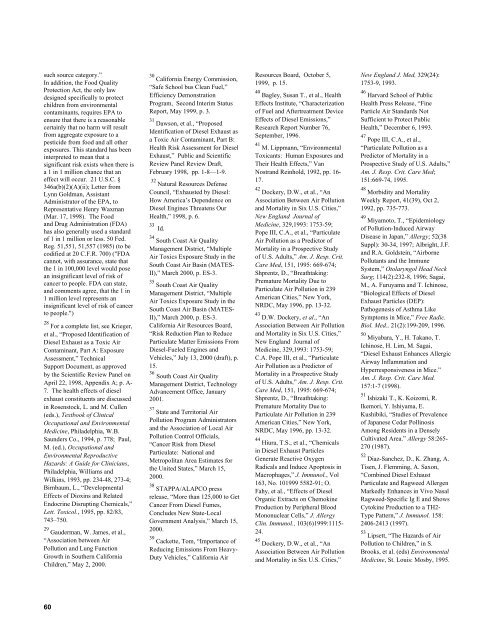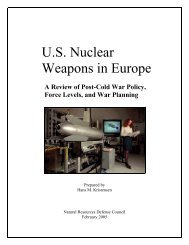NRDC: No Breathing in the Aisles: Diesel Exhaust Inside School ...
NRDC: No Breathing in the Aisles: Diesel Exhaust Inside School ...
NRDC: No Breathing in the Aisles: Diesel Exhaust Inside School ...
Create successful ePaper yourself
Turn your PDF publications into a flip-book with our unique Google optimized e-Paper software.
such source category.”<br />
In addition, <strong>the</strong> Food Quality<br />
Protection Act, <strong>the</strong> only law<br />
designed specifically to protect<br />
children from environmental<br />
contam<strong>in</strong>ants, requires EPA to<br />
ensure that <strong>the</strong>re is a reasonable<br />
certa<strong>in</strong>ly that no harm will result<br />
from aggregate exposure to a<br />
pesticide from food and all o<strong>the</strong>r<br />
exposures. This standard has been<br />
<strong>in</strong>terpreted to mean that a<br />
significant risk exists when <strong>the</strong>re is<br />
a 1 <strong>in</strong> 1 million chance that an<br />
effect will occur. 21 U.S.C. §<br />
346a(b)(2)(A)(ii); Letter from<br />
Lynn Goldman, Assistant<br />
Adm<strong>in</strong>istrator of <strong>the</strong> EPA, to<br />
Representative Henry Waxman<br />
(Mar. 17, 1998). The Food<br />
and Drug Adm<strong>in</strong>istration (FDA)<br />
has also generally used a standard<br />
of 1 <strong>in</strong> 1 million or less. 50 Fed.<br />
Reg. 51,551, 51,557 (1985) (to be<br />
codified at 20 C.F.R. 700) ("FDA<br />
cannot, with assurance, state that<br />
<strong>the</strong> 1 <strong>in</strong> 100,000 level would pose<br />
an <strong>in</strong>significant level of risk of<br />
cancer to people. FDA can state,<br />
and comments agree, that <strong>the</strong> 1 <strong>in</strong><br />
1 million level represents an<br />
<strong>in</strong>significant level of risk of cancer<br />
to people.")<br />
28<br />
For a complete list, see Krieger,<br />
et al., “Proposed Identification of<br />
<strong>Diesel</strong> <strong>Exhaust</strong> as a Toxic Air<br />
Contam<strong>in</strong>ant, Part A: Exposure<br />
Assessment,” Technical<br />
Support Document, as approved<br />
by <strong>the</strong> Scientific Review Panel on<br />
April 22, 1998, Appendix A; p. A-<br />
7. The health effects of diesel<br />
exhaust constituents are discussed<br />
<strong>in</strong> Rosenstock, L. and M. Cullen<br />
(eds.), Textbook of Cl<strong>in</strong>ical<br />
Occupational and Environmental<br />
Medic<strong>in</strong>e, Philadelphia, W.B.<br />
Saunders Co., 1994, p. 778; Paul,<br />
M. (ed.), Occupational and<br />
Environmental Reproductive<br />
Hazards: A Guide for Cl<strong>in</strong>icians,<br />
Philadelphia, Williams and<br />
Wilk<strong>in</strong>s, 1993, pp. 234-48, 273-4;<br />
Birnbaum, L., “Developmental<br />
Effects of Diox<strong>in</strong>s and Related<br />
Endocr<strong>in</strong>e Disrupt<strong>in</strong>g Chemicals,”<br />
Lett. Toxicol., 1995, pp. 82/83,<br />
743–750.<br />
29<br />
Gauderman, W. James, et al.,<br />
“Association between Air<br />
Pollution and Lung Function<br />
Growth <strong>in</strong> Sou<strong>the</strong>rn California<br />
Children,” May 2, 2000.<br />
60<br />
30<br />
California Energy Commission,<br />
“Safe <strong>School</strong> bus Clean Fuel,”<br />
Efficiency Demonstration<br />
Program, Second Interim Status<br />
Report, May 1999, p. 3.<br />
31<br />
Dawson, et al., “Proposed<br />
Identification of <strong>Diesel</strong> <strong>Exhaust</strong> as<br />
a Toxic Air Contam<strong>in</strong>ant, Part B:<br />
Health Risk Assessment for <strong>Diesel</strong><br />
<strong>Exhaust</strong>,” Public and Scientific<br />
Review Panel Review Draft,<br />
February 1998, pp. 1-8—1-9.<br />
32 Natural Resources Defense<br />
Council, “<strong>Exhaust</strong>ed by <strong>Diesel</strong>:<br />
How America’s Dependence on<br />
<strong>Diesel</strong> Eng<strong>in</strong>es Threatens Our<br />
Health,” 1998, p. 6.<br />
33<br />
Id.<br />
34<br />
South Coast Air Quality<br />
Management District, “Multiple<br />
Air Toxics Exposure Study <strong>in</strong> <strong>the</strong><br />
South Coast Air Bas<strong>in</strong> (MATES-<br />
II),” March 2000, p. ES-3.<br />
35<br />
South Coast Air Quality<br />
Management District, “Multiple<br />
Air Toxics Exposure Study <strong>in</strong> <strong>the</strong><br />
South Coast Air Bas<strong>in</strong> (MATES-<br />
II),” March 2000, p. ES-3.<br />
California Air Resources Board,<br />
“Risk Reduction Plan to Reduce<br />
Particulate Matter Emissions From<br />
<strong>Diesel</strong>-Fueled Eng<strong>in</strong>es and<br />
Vehicles,” July 13, 2000 (draft), p.<br />
15.<br />
36<br />
South Coast Air Quality<br />
Management District, Technology<br />
Advancement Office, January<br />
2001.<br />
37<br />
State and Territorial Air<br />
Pollution Program Adm<strong>in</strong>istrators<br />
and <strong>the</strong> Association of Local Air<br />
Pollution Control Officials,<br />
“Cancer Risk from <strong>Diesel</strong><br />
Particulate: National and<br />
Metropolitan Area Estimates for<br />
<strong>the</strong> United States,” March 15,<br />
2000.<br />
38<br />
STAPPA/ALAPCO press<br />
release, “More than 125,000 to Get<br />
Cancer From <strong>Diesel</strong> Fumes,<br />
Concludes New State-Local<br />
Government Analysis,” March 15,<br />
2000.<br />
39<br />
Cackette, Tom, “Importance of<br />
Reduc<strong>in</strong>g Emissions From Heavy-<br />
Duty Vehicles,” California Air<br />
Resources Board, October 5,<br />
1999, p. 15.<br />
40<br />
Bagley, Susan T., et al., Health<br />
Effects Institute, “Characterization<br />
of Fuel and Aftertreatment Device<br />
Effects of <strong>Diesel</strong> Emissions,”<br />
Research Report Number 76,<br />
September, 1996.<br />
41<br />
M. Lippmann, “Environmental<br />
Toxicants: Human Exposures and<br />
Their Health Effects,” Van<br />
<strong>No</strong>strand Re<strong>in</strong>hold, 1992, pp. 16-<br />
17.<br />
42<br />
Dockery, D.W., et al., “An<br />
Association Between Air Pollution<br />
and Mortality <strong>in</strong> Six U.S. Cities,”<br />
New England Journal of<br />
Medic<strong>in</strong>e, 329,1993: 1753-59;<br />
Pope III, C.A., et al., “Particulate<br />
Air Pollution as a Predictor of<br />
Mortality <strong>in</strong> a Prospective Study<br />
of U.S. Adults,” Am. J. Resp. Crit.<br />
Care Med, 151, 1995: 669-674;<br />
Shprentz, D., “Breathtak<strong>in</strong>g:<br />
Premature Mortality Due to<br />
Particulate Air Pollution <strong>in</strong> 239<br />
American Cities,” New York,<br />
<strong>NRDC</strong>, May 1996, pp. 13-32.<br />
43<br />
D.W. Dockery, et al., “An<br />
Association Between Air Pollution<br />
and Mortality <strong>in</strong> Six U.S. Cities,”<br />
New England Journal of<br />
Medic<strong>in</strong>e, 329,1993: 1753-59;<br />
C.A. Pope III, et al., “Particulate<br />
Air Pollution as a Predictor of<br />
Mortality <strong>in</strong> a Prospective Study<br />
of U.S. Adults,” Am. J. Resp. Crit.<br />
Care Med, 151, 1995: 669-674;<br />
Shprentz, D., “Breathtak<strong>in</strong>g:<br />
Premature Mortality Due to<br />
Particulate Air Pollution <strong>in</strong> 239<br />
American Cities,” New York,<br />
<strong>NRDC</strong>, May 1996, pp. 13-32.<br />
44<br />
Hiura, T.S., et al., “Chemicals<br />
<strong>in</strong> <strong>Diesel</strong> <strong>Exhaust</strong> Particles<br />
Generate Reactive Oxygen<br />
Radicals and Induce Apoptosis <strong>in</strong><br />
Macrophages,” J. Immunol., Vol<br />
163, <strong>No</strong>. 101999 5582-91; O.<br />
Fahy, et al., “Effects of <strong>Diesel</strong><br />
Organic Extracts on Chemok<strong>in</strong>e<br />
Production by Peripheral Blood<br />
Mononuclear Cells,” J. Allergy<br />
Cl<strong>in</strong>. Immunol., 103(6)1999:1115-<br />
24.<br />
45<br />
Dockery, D.W., et al., “An<br />
Association Between Air Pollution<br />
and Mortality <strong>in</strong> Six U.S. Cities,”<br />
New England J. Med, 329(24):<br />
1753-9, 1993.<br />
46<br />
Harvard <strong>School</strong> of Public<br />
Health Press Release, “F<strong>in</strong>e<br />
Particle Air Standards <strong>No</strong>t<br />
Sufficient to Protect Public<br />
Health,” December 6, 1993.<br />
47<br />
Pope III, C.A., et al.,<br />
“Particulate Pollution as a<br />
Predictor of Mortality <strong>in</strong> a<br />
Prospective Study of U.S. Adults,”<br />
Am. J. Resp. Crit. Care Med;<br />
151:669-74, 1995.<br />
48<br />
Morbidity and Mortality<br />
Weekly Report, 41(39), Oct 2,<br />
1992, pp. 735-773.<br />
49<br />
Miyamoto, T., “Epidemiology<br />
of Pollution-Induced Airway<br />
Disease <strong>in</strong> Japan,” Allergy; 52(38<br />
Suppl): 30-34, 1997; Albright, J.F.<br />
and R.A. Goldste<strong>in</strong>, “Airborne<br />
Pollutants and <strong>the</strong> Immune<br />
System,” Otolaryngol Head Neck<br />
Surg; 114(2):232-8, 1996; Sagai,<br />
M., A. Furuyama and T. Ich<strong>in</strong>ose,<br />
“Biological Effects of <strong>Diesel</strong><br />
<strong>Exhaust</strong> Particles (DEP):<br />
Pathogenesis of Asthma Like<br />
Symptoms <strong>in</strong> Mice,” Free Radic.<br />
Biol. Med., 21(2):199-209, 1996.<br />
50<br />
Miyabara, Y., H. Takano, T.<br />
Ich<strong>in</strong>ose, H. Lim, M. Sagai,<br />
“<strong>Diesel</strong> <strong>Exhaust</strong> Enhances Allergic<br />
Airway Inflammation and<br />
Hyperresponsiveness <strong>in</strong> Mice.”<br />
Am. J. Resp. Crit. Care Med.<br />
157:1-7 (1998).<br />
51<br />
Ishizaki T., K. Koizomi, R.<br />
Ikemori, Y. Ishiyama, E.<br />
Kushibiki, “Studies of Prevalence<br />
of Japanese Cedar Poll<strong>in</strong>osis<br />
Among Residents <strong>in</strong> a Densely<br />
Cultivated Area.” Allergy 58:265-<br />
270 (1987).<br />
52<br />
Diaz-Sanchez, D., K. Zhang, A.<br />
Tisen, J. Flemm<strong>in</strong>g, A. Saxon,<br />
“Comb<strong>in</strong>ed <strong>Diesel</strong> <strong>Exhaust</strong><br />
Particulate and Ragweed Allergen<br />
Markedly Enhances <strong>in</strong> Vivo Nasal<br />
Ragweed-Specific Ig E and Shows<br />
Cytok<strong>in</strong>e Production to a TH2-<br />
Type Pattern,” J. Immunol. 158:<br />
2406-2413 (1997).<br />
53<br />
Lipsett, “The Hazards of Air<br />
Pollution to Children,” <strong>in</strong> S.<br />
Brooks, et al. (eds) Environmental<br />
Medic<strong>in</strong>e, St. Louis: Mosby, 1995.
















